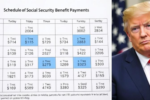Recent claims by public figures like Donald Trump and Elon Musk have raised questions about Social Security payments being made to deceased individuals. However, these allegations are largely unfounded. The Social Security Administration (SSA) has stringent processes in place to prevent such errors. Here’s a breakdown of the facts surrounding these claims and what you need to know.
1. The Origins of the Claims
Former President Donald Trump and billionaire Elon Musk have suggested that tens of millions of dead people are receiving Social Security benefits. These claims have sparked widespread debate and misinformation on social media. While such statements may attract attention, they do not align with the reality of how the SSA operates.
The SSA has a Death Master File (DMF), a comprehensive database updated regularly to track deaths reported by funeral homes, family members, and other official sources. This database is used to terminate benefits for deceased individuals, reducing the risk of improper payments.
2. Understanding the Death Master File
The Death Master File plays a crucial role in preventing Social Security fraud. When a death is reported, the SSA updates its records within days. Here’s how the process works:
- Death Reporting: Funeral homes and next of kin are required to notify the SSA of a person’s death. In most cases, this happens promptly.
- Cross-Referencing Records: The SSA cross-references its data with other federal and state agencies to ensure accuracy.
- Termination of Benefits: Once a death is confirmed, the SSA stops payments immediately.
Despite the sophistication of this system, occasional errors can occur. However, these are rare and typically involve isolated cases rather than widespread systemic failures.
3. The Scale of Overpayments
While the notion of “tens of millions” of improper payments is exaggerated, the SSA’s Office of the Inspector General (OIG) has identified cases of overpayments to deceased individuals. In 2023, a report found that approximately $8 million was mistakenly paid to deceased beneficiaries over a decade—a small fraction of the SSA’s total annual disbursements, which exceed $1 trillion.
The SSA actively works to recover overpayments. In many cases, these payments occur due to delays in death reporting or administrative errors, not systemic fraud. The agency has implemented measures such as enhanced data sharing and automation to minimize these occurrences.
4. Political and Social Implications
The claims about dead individuals receiving Social Security checks are not just inaccurate but also politically charged. They perpetuate myths about government inefficiency and misuse of taxpayer dollars. For instance, such narratives can undermine public trust in vital social programs and create unnecessary fear about the sustainability of Social Security.
These allegations also highlight the importance of media literacy. Viral claims often lack context and are used to push specific agendas. Understanding how the SSA operates can help dispel misinformation and ensure public confidence in the system.
5. How the Public Can Help
Preventing errors in Social Security payments requires cooperation from the public. Here are some steps individuals can take:
- Promptly Report Deaths: Family members and funeral homes should notify the SSA as soon as possible to avoid overpayments.
- Verify Records: Check the SSA’s online portal to ensure the accuracy of your personal information.
- Stay Informed: Rely on reputable sources for information about Social Security policies and operations.
For more detailed information about Social Security’s processes, visit the Social Security Administration’s official website.
Conclusion
Claims that tens of millions of dead people are receiving Social Security checks are unfounded and misleading. The SSA’s robust systems for tracking and terminating payments to deceased individuals are effective, with only a small margin for error. Understanding these processes can help combat misinformation and preserve trust in one of the nation’s most important social programs.
Disclaimer – Our team has carefully fact-checked this article to make sure it’s accurate and free from any misinformation. We’re dedicated to keeping our content honest and reliable for our readers.







